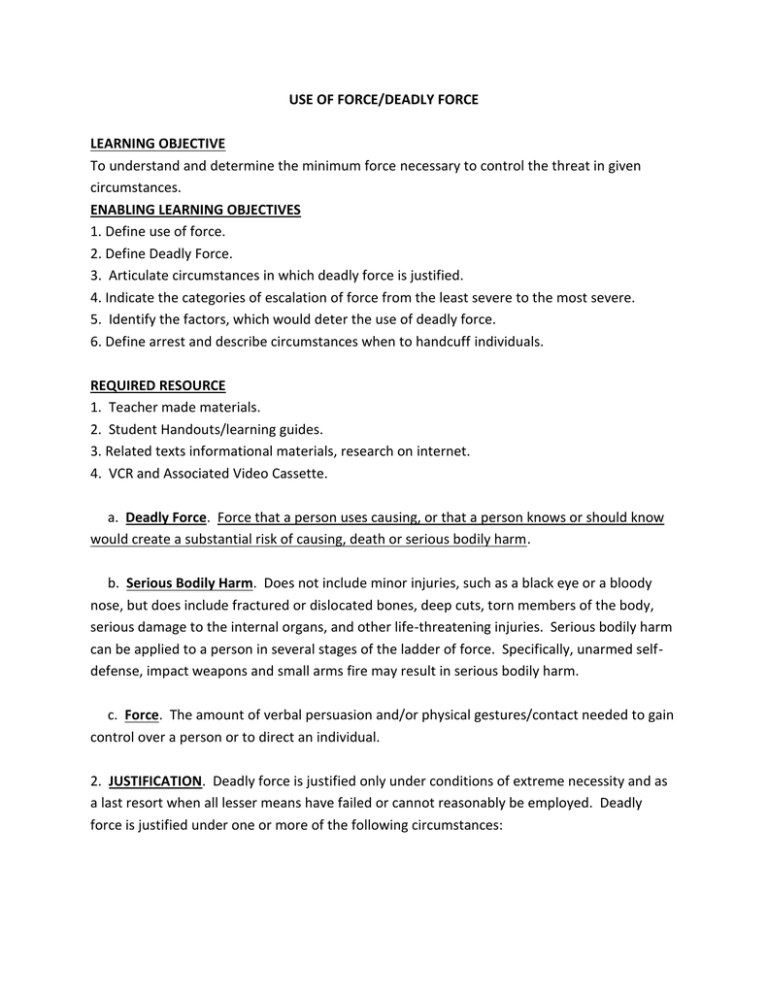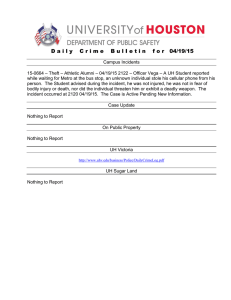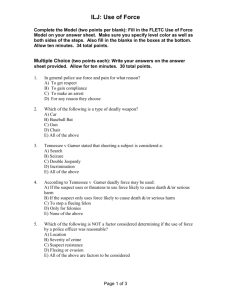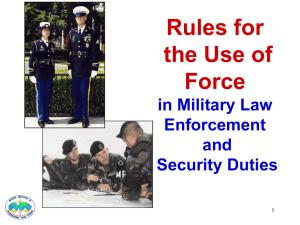USE OF FORCE/DEADLY FORCE LEARNING OBJECTIVE ENABLING LEARNING OBJECTIVES
advertisement

USE OF FORCE/DEADLY FORCE LEARNING OBJECTIVE To understand and determine the minimum force necessary to control the threat in given circumstances. ENABLING LEARNING OBJECTIVES 1. Define use of force. 2. Define Deadly Force. 3. Articulate circumstances in which deadly force is justified. 4. Indicate the categories of escalation of force from the least severe to the most severe. 5. Identify the factors, which would deter the use of deadly force. 6. Define arrest and describe circumstances when to handcuff individuals. REQUIRED RESOURCE 1. Teacher made materials. 2. Student Handouts/learning guides. 3. Related texts informational materials, research on internet. 4. VCR and Associated Video Cassette. a. Deadly Force. Force that a person uses causing, or that a person knows or should know would create a substantial risk of causing, death or serious bodily harm. b. Serious Bodily Harm. Does not include minor injuries, such as a black eye or a bloody nose, but does include fractured or dislocated bones, deep cuts, torn members of the body, serious damage to the internal organs, and other life-threatening injuries. Serious bodily harm can be applied to a person in several stages of the ladder of force. Specifically, unarmed selfdefense, impact weapons and small arms fire may result in serious bodily harm. c. Force. The amount of verbal persuasion and/or physical gestures/contact needed to gain control over a person or to direct an individual. 2. JUSTIFICATION. Deadly force is justified only under conditions of extreme necessity and as a last resort when all lesser means have failed or cannot reasonably be employed. Deadly force is justified under one or more of the following circumstances: a. Self Defense and Defense of Others When deadly force reasonably appears to be necessary to protect law enforcement or security personnel who reasonably believe themselves or others to be in imminent danger of death or serious bodily harm. b. Assets Involving National Security. When deadly force reasonably appears necessary to prevent the actual theft or sabotage of assets vital to national security. DOD assets shall be specifically designated as "vital to national security" only when their loss, damage, or compromise would seriously jeopardize the fulfillment of a national defense mission. Examples include nuclear weapons; nuclear command, control, and communications facilities; and designated restricted areas containing strategic operational assets, sensitive codes, or special access programs. c. Assets Not Involving National Security but Inherently Dangerous to Others. When deadly force reasonably appears to be necessary to prevent the actual theft or sabotage of resources, such as operable weapons or ammunition, that are inherently dangerous to others; i.e., assets that, in the hands of an unauthorized individual, present a substantial potential danger of death or serious bodily harm to others. Examples include high-risk portable and lethal missiles, rockets, arms, ammunition, explosives, chemical agents, and special nuclear material. d. Serious Offenses Against Persons. When deadly force reasonably appears necessary to prevent the commission of a serious offense involving violence and threatening death or serious bodily harm. Examples include murder, armed robbery, and aggravated assault. e. Arrest or Apprehension. When deadly force reasonably appears to be necessary to arrest, apprehend, or prevent the escape of a person who, there is probable cause to believe they have committed an offense of the nature specified in subsections 2a through 2d above. f. Escapes. Reasonably appears to be necessary to prevent the escape of a prisoner, provided law enforcement or security personnel have probable cause to believe that the escaping prisoner poses a threat of serious bodily harm either to security personnel or others. 3. DEADLY FORCE PRE-CONDITIONS. Before using deadly force against another individual to prevent serous bodily harm of death to yourself or others, the following pre-conditions must be met. Presence of these pre-conditions authorizes the use of deadly force: 1 a. OPPORTUNITY: In order for a person to have the ability to inflict damage or serious bodily harm, he or she must be present or in place. b. CAPABILITY: Capability would be present if the individual possesses the actual ability to inflict serious bodily injury/death. c. INTENT: A hostile or dangerous person must clearly indicate the INTENT to cause damage to protected resources, or bodily harm to others. Are they actually aiming a weapon or other dangerous object in a fashion that is capable of, and is obviously being used with the intention of, inflicting damage or serious bodily harm to persons. 4. ESCALATION OF FORCE. The escalation of force can be defined as taking means appropriate to the threat or equal to the threat. These methods must be used from the least severe to the most severe. Escalation of force is broken down into eight categories. They are as follows: a. Verbal Persuasion: Simply talking to an individual and persuading him/her by using your verbal skills. There are two basic levels of verbal persuasion: (1) Light Control. Giving directions and advice to individuals that are not hostile. (2) Heavy Control. Using voice reflection, giving warning orders or commands to hostile or suspected hostile individual(s). ***NOTE*** Verbal Persuasion should be used in combination with every level of force. b. Physical Confrontation: Application of unarmed self-defense/apprehension techniques and take down holds. Primary strike zones (green) include shins, instep, Achilles tendon, upper arms, forearm, buttock thigh and calf. Secondary strike zones (yellow) include collarbone, knee joint, shoulder blades, elbow, back of hand, upper arm, shoulder, upper abdomen. Final strike zones (red) include temple, ears, eyes, bridge of nose, upper lip, jaw, throat, solar plexus, groin, back of neck, hollow behind ear, kidney, tailbone, rib cage and spine. c. Hand restraints: Hand cuffs and flex cuffs. d. Oleoresin Capsicum (Pepper Spray): OC spray may be used by officers to subdue a person if circumstances warrant it’s use. Pepper spray should be used as a last resort in an altercation with a violent person. If they are used, treatment of the individual should be instituted as soon as possible. 2 e. Impact Weapons: ASP baton, PR-24, riot baton and etc may be used by officers to subdue a subject or in self defense if such circumstances warrant it’s use. The baton may be used as a blocking device to ward off blows of an assailant or as a repelling device in crowd control situations. The baton must be considered a potentially deadly weapon. Also areas not to strike are: groin, kidney spine, tailbone, upper solar plexus, and area above the stomach. f. PWD: Release of the Police working dog. g. Approved non-lethal weapons: Shotgun beanbag rounds. h. Firearms: A firearm shall never be drawn unless its use is deemed necessary by the officer and the situation which caused you to draw would be proper under the use of force guidelines. Firearms may be drawn and readied for use in situations where it is anticipated that they may actually be required. NOTE: Any use of physical force requires the immediate notification of your supervisor, and completion of required use of force forms. 5. Additional Consideration for the Use of Firearms: a. Warning shots are prohibited. b. When a firearm is discharged, it will be fired with the intent of rendering the person(s) at whom it is discharged incapable of continuing the activity or course of behavior prompting the individual to shoot. c. Shots shall be fired only with due regard for the safety of innocent bystanders. d. In the case of holstered weapons, a weapon should not be removed from the holster unless there is reasonable expectation that use of the weapon may be necessary. e. Firearms will not be fired from a moving vehicle at any time. 3 g. All instances where negligence results in a firearm discharge, it will be immediately reported to the security officer for investigative assignment 6. REVIEW a. Define Deadly Force. b. State those circumstances in which deadly force is authorized. c. Indicate the categories of escalation of force from the least severe to the most severe. d. Identify the factors which would deter the use of deadly force. e. What are the three pre-conditions for the use of force? f. Articulate when and how deadly force is justified. Mechanics of arrest: Officer discretion in arrest/non-arrest situation Risk factors and appropriate response: Suspect's mental attitude/behavioral disorders Time and location Intoxication Spectator’s supportive attitude toward subject Officer attitude Describe and analyze the advantages of the various methods of approaching, confronting and interviewing the suspect. Stress pat down vs. search Explain and demonstrate proper means of applying handcuffs (Stress safety throughout Positions: Handcuffs are a temporary restraining device only! Provide opportunity for cadet/student to practice proper procedures of handcuffing on other cadet/student. 4 Explain and demonstrate proper procedures for physical search of suspect. Stress safety throughout demonstration and practice Provide opportunity for cadet/student to practice proper procedures of searching on other cadets/students Wall search: Most authorities agree that the wall search is a high-risk technique. Explain and demonstrate proper procedures when escorting and transporting suspects. Suspect(s) are to be handcuffed at all times in every situation, as outlined below. Walking One officer, two suspects: Two officers, one suspect: Two officers, two suspects: Transporting One officer, one suspect: Two officers, one suspect: Two officers, two suspects: Provide opportunity for cadet/student to practice proper escorting and transporting procedures Demonstrate the ability to effect an arrest. Handcuffing Techniques Felony Arrest / Takedown of Suspect Pat down Search Techniques 5



